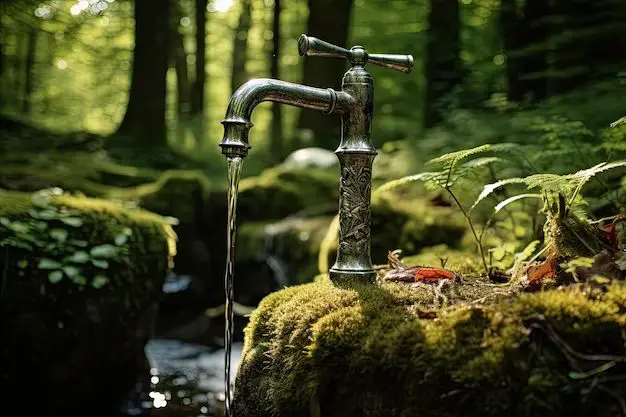A frost free outside faucet, also known as a hose bibb or sillcock, is a type of outdoor water faucet that is designed to prevent freezing and damage during cold weather. Unlike a standard outdoor faucet, a frost free model has an internal design that allows water to drain out completely after use, preventing any remaining water from freezing inside the faucet body and causing cracks or leaks. Here’s an overview of how frost free outside faucets work:
Page Contents
Key Components
A frost free outdoor faucet has three main components:
- Vacuum breaker – This is located at the top of the faucet and prevents backflow of contaminated water into the house plumbing system.
- Inlet stem – The inlet stem is connected to the household water supply line and allows water into the faucet body.
- Outlet stem – The outlet stem is hollow and allows water to flow through and exit via the faucet spout when the valve is open.
Inside the faucet body is an internal valve and seat washer that controls water flow. When the faucet handle is turned to the open position, the valve lifts up off the seat washer and allows water to flow through the outlet stem. When the handle is turned to the closed position, the valve presses back down on the seat washer, blocking water flow.
Drainage System
The key feature that makes a frost free faucet work is its drainage system located inside the outlet stem. Near the tip of the outlet stem is a small hole called a weep hole. Further up inside the outlet stem is an angled internal drainage channel.
When the faucet is turned off after use, any remaining water in the outlet stem is allowed to drain out through the weep hole. As water drains out, air is able to enter the outlet stem through the weep hole and rise up through the drainage channel inside. This incoming air breaks the vacuum seal and ensures that water completely empties from the stem.
Freeze Prevention
Because the weep hole and drainage system allow a frost free faucet’s outlet stem to fully empty after each use, there is no water left standing inside the faucet body during freezing temperatures. This prevents any potential freeze damage.
Without this drainage system, a small amount of water would remain in the outlet stem and could freeze during cold weather. The resulting ice expansion inside the faucet body would lead to cracks, leaks, and damage.
Installation Tips
To get the most out of a frost free faucet, there are some important installation guidelines to follow:
- Mount the faucet on an exterior wall of the house at least 6-12 inches above ground level. This prevents freezing of any drainage water under the faucet body.
- Slope any connecting pipes or hoses slightly downward to facilitate draining.
- Seal all connections and joints tightly to prevent leaks.
- Insulate underground water supply pipes leading to the faucet.
- Install a shutoff valve inside the house for easy winterization.
Maintenance
To keep a frost free faucet working properly, follow these maintenance practices:
- In cold climates, shut off the faucet’s indoor water supply and drain all water from pipes and hoses before winter. This completes the winterization process.
- Make sure the faucet is mounted securely and check for any leaks or drips.
- Clear any debris, dirt or nests from the faucet’s weep hole.
- Replace washers, o-rings or stems if drips or leaks develop.
- Consider installing an insulated faucet cover for additional freeze protection during extreme cold.
Troubleshooting Issues
If you experience any problems with your frost free faucet, here are some troubleshooting tips:
| Issue | Possible Cause | Solution |
|---|---|---|
| Water leaks from handle or spout when turned off | Worn out washer/seat | Replace washers and seats |
| Faucet leaks around body | Loose connections | Tighten fittings; seal with pipe joint compound |
| No water flow | Shutoff valve closed | Open shutoff valve |
| Water drips from spout | Damaged/clogged weep hole | Clear debris from weep hole |
| Faucet handle hard to open | Mineral buildup | Clean inlet screen; de-scale faucet |
Advantages of Frost Free Faucets
There are several benefits to using a frost free hose bibb:
- Freeze protection – No risk of frozen or burst pipes during winter.
- Prevents water damage – Drainage system stops leaks from cracks or splits in the faucet body.
- Easy winterization – No need to disconnect hoses or wrap faucets in winter.
- Reduced maintenance – Drainage system keeps faucet working smoothly year-round.
- Long lifespan – Durable brass construction resists corrosion and lasts for years.
Conclusion
Frost free sillcocks provide a convenient and maintenance-free way to access outdoor water year-round, even in freezing climates. By utilizing a weep hole and angled drainage channel, they are engineered to prevent freezing cracks and burst pipes during winter. While proper installation is important, frost free faucets eliminate the need for disconnecting hoses or wrapping outdoor faucets seasonally. With proper drainage and winterization, they can provide lasting performance with minimal care required.
